Economic Impact of Sports Events
VerifiedAdded on 2022/11/25
|11
|2261
|412
AI Summary
This document discusses the economic impact of hosting sports events, including job creation, tourism management, and infrastructure development. It explores the positive aspects such as domestic and international expenditures, as well as the negative impacts such as crowding out and pollution. The document also covers the role of sports events in urban regeneration, including social, economic, physical, and environmental improvements. Additionally, it delves into the concept of ambush marketing and its effectiveness in promoting sports events. References are provided for further reading.
Contribute Materials
Your contribution can guide someone’s learning journey. Share your
documents today.
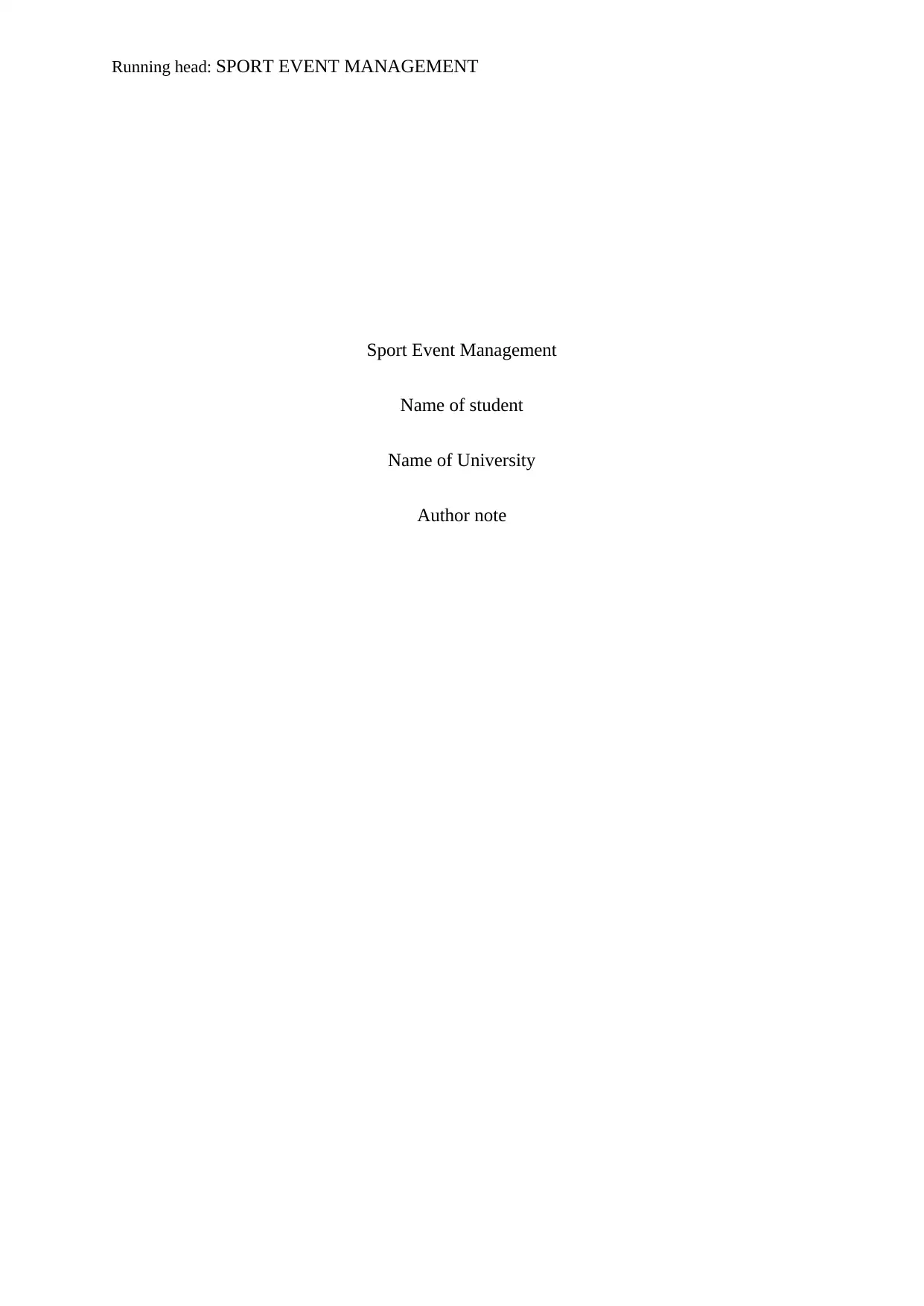
Running head: SPORT EVENT MANAGEMENT
Sport Event Management
Name of student
Name of University
Author note
Sport Event Management
Name of student
Name of University
Author note
Secure Best Marks with AI Grader
Need help grading? Try our AI Grader for instant feedback on your assignments.

1
SPORT EVENT MANAGEMENT
Table of Contents
Economic impact report on sports events..................................................................................3
Sports events and urban generation............................................................................................3
Ambush marketing.....................................................................................................................4
References..................................................................................................................................5
SPORT EVENT MANAGEMENT
Table of Contents
Economic impact report on sports events..................................................................................3
Sports events and urban generation............................................................................................3
Ambush marketing.....................................................................................................................4
References..................................................................................................................................5
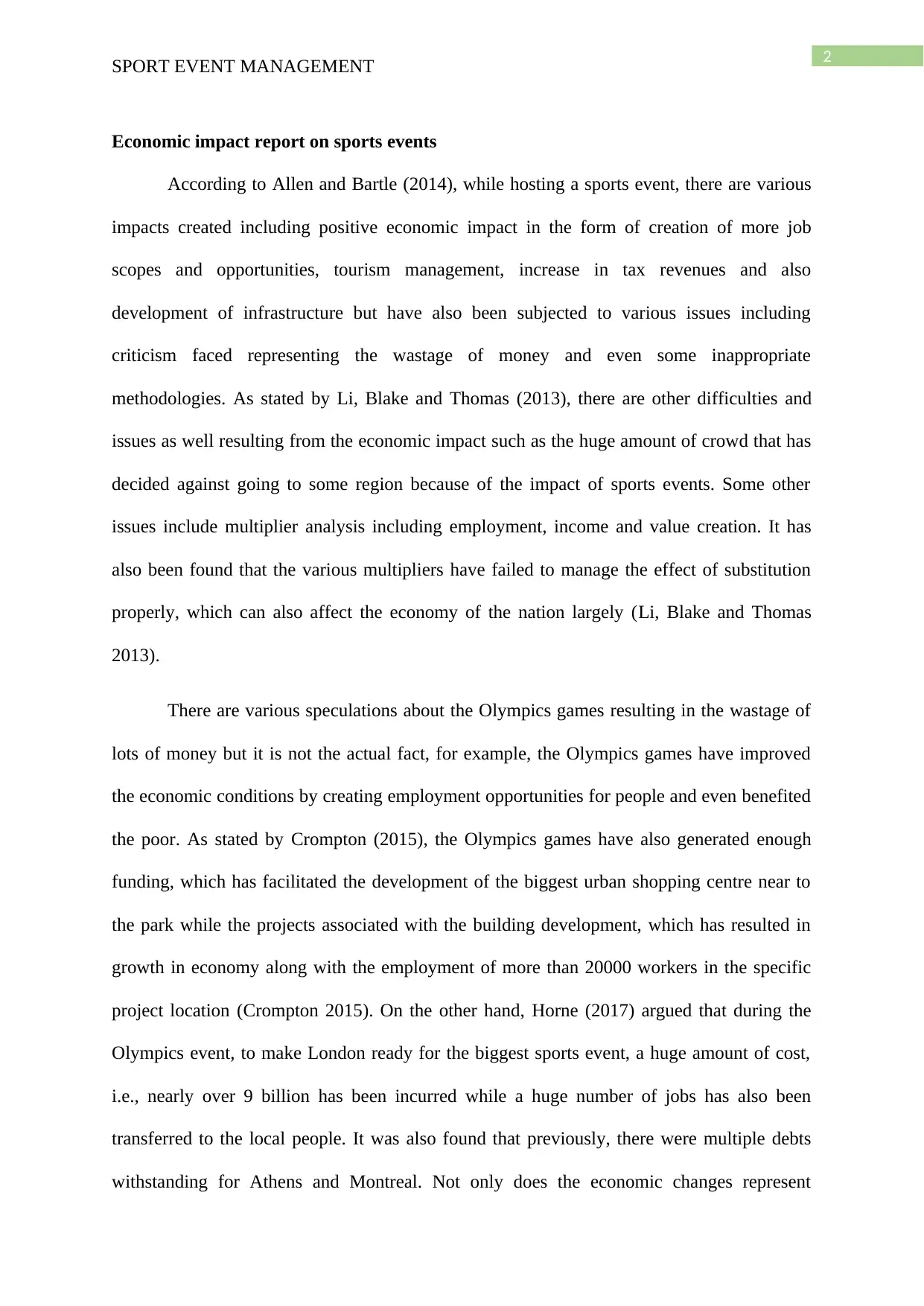
2
SPORT EVENT MANAGEMENT
Economic impact report on sports events
According to Allen and Bartle (2014), while hosting a sports event, there are various
impacts created including positive economic impact in the form of creation of more job
scopes and opportunities, tourism management, increase in tax revenues and also
development of infrastructure but have also been subjected to various issues including
criticism faced representing the wastage of money and even some inappropriate
methodologies. As stated by Li, Blake and Thomas (2013), there are other difficulties and
issues as well resulting from the economic impact such as the huge amount of crowd that has
decided against going to some region because of the impact of sports events. Some other
issues include multiplier analysis including employment, income and value creation. It has
also been found that the various multipliers have failed to manage the effect of substitution
properly, which can also affect the economy of the nation largely (Li, Blake and Thomas
2013).
There are various speculations about the Olympics games resulting in the wastage of
lots of money but it is not the actual fact, for example, the Olympics games have improved
the economic conditions by creating employment opportunities for people and even benefited
the poor. As stated by Crompton (2015), the Olympics games have also generated enough
funding, which has facilitated the development of the biggest urban shopping centre near to
the park while the projects associated with the building development, which has resulted in
growth in economy along with the employment of more than 20000 workers in the specific
project location (Crompton 2015). On the other hand, Horne (2017) argued that during the
Olympics event, to make London ready for the biggest sports event, a huge amount of cost,
i.e., nearly over 9 billion has been incurred while a huge number of jobs has also been
transferred to the local people. It was also found that previously, there were multiple debts
withstanding for Athens and Montreal. Not only does the economic changes represent
SPORT EVENT MANAGEMENT
Economic impact report on sports events
According to Allen and Bartle (2014), while hosting a sports event, there are various
impacts created including positive economic impact in the form of creation of more job
scopes and opportunities, tourism management, increase in tax revenues and also
development of infrastructure but have also been subjected to various issues including
criticism faced representing the wastage of money and even some inappropriate
methodologies. As stated by Li, Blake and Thomas (2013), there are other difficulties and
issues as well resulting from the economic impact such as the huge amount of crowd that has
decided against going to some region because of the impact of sports events. Some other
issues include multiplier analysis including employment, income and value creation. It has
also been found that the various multipliers have failed to manage the effect of substitution
properly, which can also affect the economy of the nation largely (Li, Blake and Thomas
2013).
There are various speculations about the Olympics games resulting in the wastage of
lots of money but it is not the actual fact, for example, the Olympics games have improved
the economic conditions by creating employment opportunities for people and even benefited
the poor. As stated by Crompton (2015), the Olympics games have also generated enough
funding, which has facilitated the development of the biggest urban shopping centre near to
the park while the projects associated with the building development, which has resulted in
growth in economy along with the employment of more than 20000 workers in the specific
project location (Crompton 2015). On the other hand, Horne (2017) argued that during the
Olympics event, to make London ready for the biggest sports event, a huge amount of cost,
i.e., nearly over 9 billion has been incurred while a huge number of jobs has also been
transferred to the local people. It was also found that previously, there were multiple debts
withstanding for Athens and Montreal. Not only does the economic changes represent
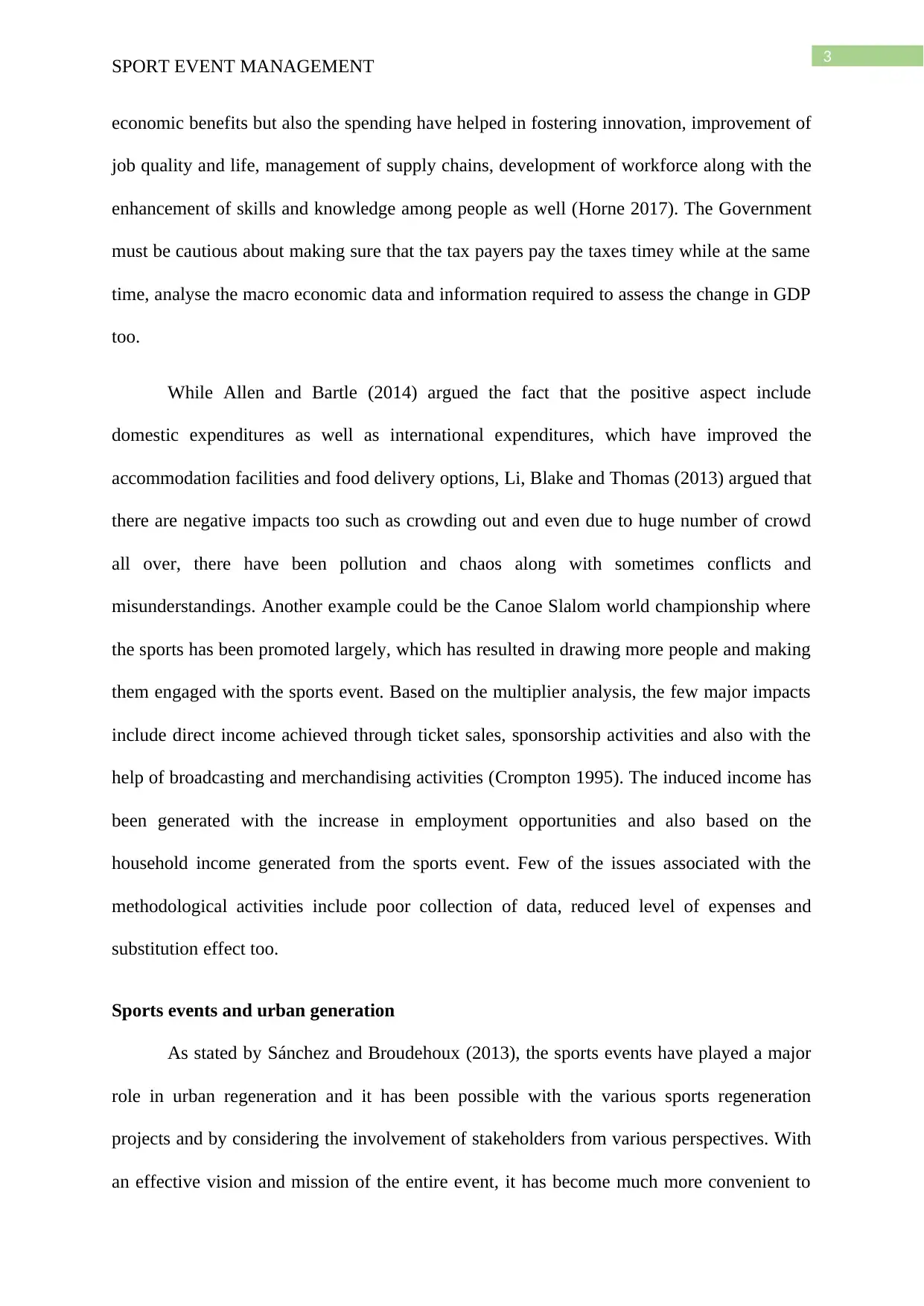
3
SPORT EVENT MANAGEMENT
economic benefits but also the spending have helped in fostering innovation, improvement of
job quality and life, management of supply chains, development of workforce along with the
enhancement of skills and knowledge among people as well (Horne 2017). The Government
must be cautious about making sure that the tax payers pay the taxes timey while at the same
time, analyse the macro economic data and information required to assess the change in GDP
too.
While Allen and Bartle (2014) argued the fact that the positive aspect include
domestic expenditures as well as international expenditures, which have improved the
accommodation facilities and food delivery options, Li, Blake and Thomas (2013) argued that
there are negative impacts too such as crowding out and even due to huge number of crowd
all over, there have been pollution and chaos along with sometimes conflicts and
misunderstandings. Another example could be the Canoe Slalom world championship where
the sports has been promoted largely, which has resulted in drawing more people and making
them engaged with the sports event. Based on the multiplier analysis, the few major impacts
include direct income achieved through ticket sales, sponsorship activities and also with the
help of broadcasting and merchandising activities (Crompton 1995). The induced income has
been generated with the increase in employment opportunities and also based on the
household income generated from the sports event. Few of the issues associated with the
methodological activities include poor collection of data, reduced level of expenses and
substitution effect too.
Sports events and urban generation
As stated by Sánchez and Broudehoux (2013), the sports events have played a major
role in urban regeneration and it has been possible with the various sports regeneration
projects and by considering the involvement of stakeholders from various perspectives. With
an effective vision and mission of the entire event, it has become much more convenient to
SPORT EVENT MANAGEMENT
economic benefits but also the spending have helped in fostering innovation, improvement of
job quality and life, management of supply chains, development of workforce along with the
enhancement of skills and knowledge among people as well (Horne 2017). The Government
must be cautious about making sure that the tax payers pay the taxes timey while at the same
time, analyse the macro economic data and information required to assess the change in GDP
too.
While Allen and Bartle (2014) argued the fact that the positive aspect include
domestic expenditures as well as international expenditures, which have improved the
accommodation facilities and food delivery options, Li, Blake and Thomas (2013) argued that
there are negative impacts too such as crowding out and even due to huge number of crowd
all over, there have been pollution and chaos along with sometimes conflicts and
misunderstandings. Another example could be the Canoe Slalom world championship where
the sports has been promoted largely, which has resulted in drawing more people and making
them engaged with the sports event. Based on the multiplier analysis, the few major impacts
include direct income achieved through ticket sales, sponsorship activities and also with the
help of broadcasting and merchandising activities (Crompton 1995). The induced income has
been generated with the increase in employment opportunities and also based on the
household income generated from the sports event. Few of the issues associated with the
methodological activities include poor collection of data, reduced level of expenses and
substitution effect too.
Sports events and urban generation
As stated by Sánchez and Broudehoux (2013), the sports events have played a major
role in urban regeneration and it has been possible with the various sports regeneration
projects and by considering the involvement of stakeholders from various perspectives. With
an effective vision and mission of the entire event, it has become much more convenient to
Secure Best Marks with AI Grader
Need help grading? Try our AI Grader for instant feedback on your assignments.
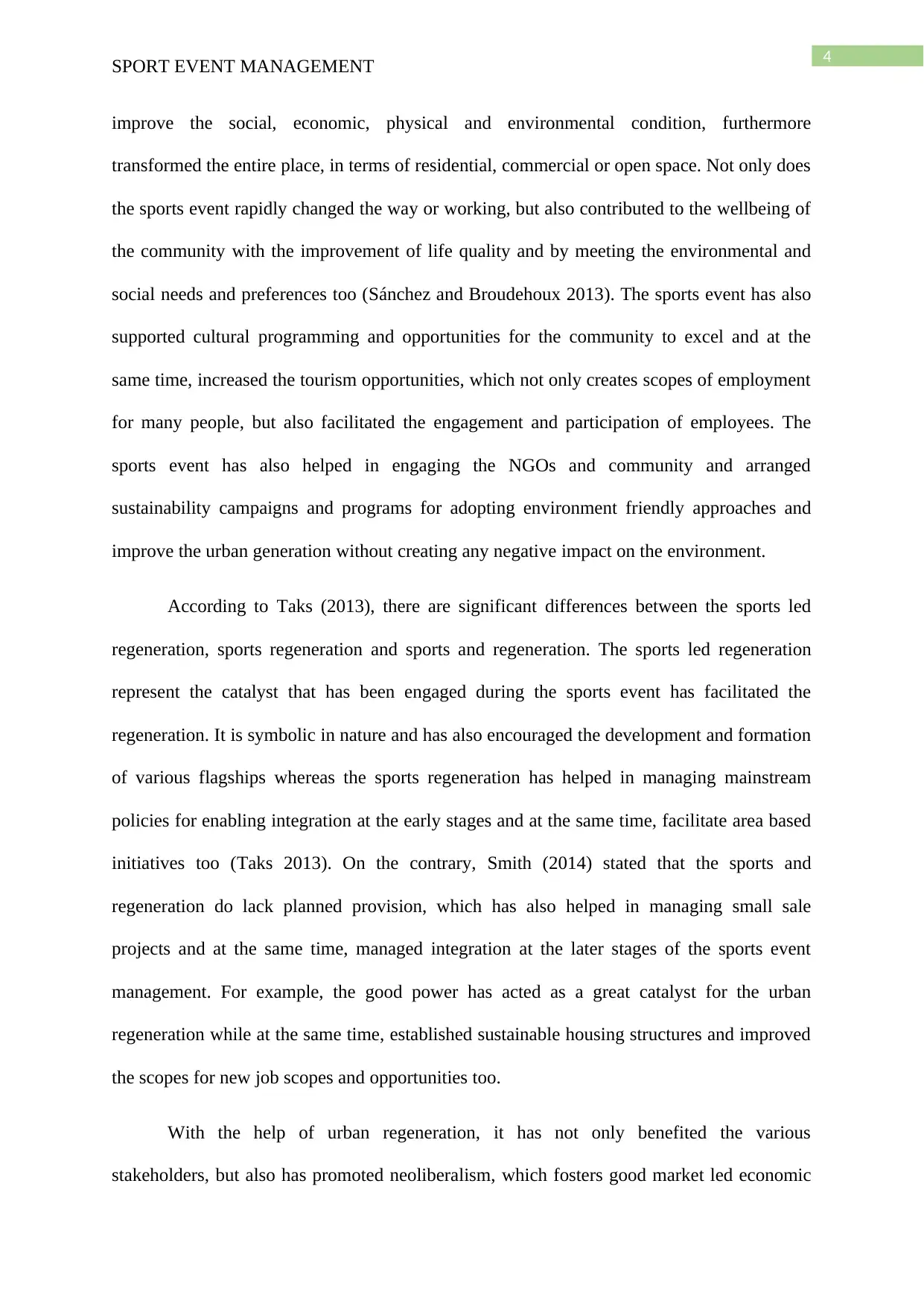
4
SPORT EVENT MANAGEMENT
improve the social, economic, physical and environmental condition, furthermore
transformed the entire place, in terms of residential, commercial or open space. Not only does
the sports event rapidly changed the way or working, but also contributed to the wellbeing of
the community with the improvement of life quality and by meeting the environmental and
social needs and preferences too (Sánchez and Broudehoux 2013). The sports event has also
supported cultural programming and opportunities for the community to excel and at the
same time, increased the tourism opportunities, which not only creates scopes of employment
for many people, but also facilitated the engagement and participation of employees. The
sports event has also helped in engaging the NGOs and community and arranged
sustainability campaigns and programs for adopting environment friendly approaches and
improve the urban generation without creating any negative impact on the environment.
According to Taks (2013), there are significant differences between the sports led
regeneration, sports regeneration and sports and regeneration. The sports led regeneration
represent the catalyst that has been engaged during the sports event has facilitated the
regeneration. It is symbolic in nature and has also encouraged the development and formation
of various flagships whereas the sports regeneration has helped in managing mainstream
policies for enabling integration at the early stages and at the same time, facilitate area based
initiatives too (Taks 2013). On the contrary, Smith (2014) stated that the sports and
regeneration do lack planned provision, which has also helped in managing small sale
projects and at the same time, managed integration at the later stages of the sports event
management. For example, the good power has acted as a great catalyst for the urban
regeneration while at the same time, established sustainable housing structures and improved
the scopes for new job scopes and opportunities too.
With the help of urban regeneration, it has not only benefited the various
stakeholders, but also has promoted neoliberalism, which fosters good market led economic
SPORT EVENT MANAGEMENT
improve the social, economic, physical and environmental condition, furthermore
transformed the entire place, in terms of residential, commercial or open space. Not only does
the sports event rapidly changed the way or working, but also contributed to the wellbeing of
the community with the improvement of life quality and by meeting the environmental and
social needs and preferences too (Sánchez and Broudehoux 2013). The sports event has also
supported cultural programming and opportunities for the community to excel and at the
same time, increased the tourism opportunities, which not only creates scopes of employment
for many people, but also facilitated the engagement and participation of employees. The
sports event has also helped in engaging the NGOs and community and arranged
sustainability campaigns and programs for adopting environment friendly approaches and
improve the urban generation without creating any negative impact on the environment.
According to Taks (2013), there are significant differences between the sports led
regeneration, sports regeneration and sports and regeneration. The sports led regeneration
represent the catalyst that has been engaged during the sports event has facilitated the
regeneration. It is symbolic in nature and has also encouraged the development and formation
of various flagships whereas the sports regeneration has helped in managing mainstream
policies for enabling integration at the early stages and at the same time, facilitate area based
initiatives too (Taks 2013). On the contrary, Smith (2014) stated that the sports and
regeneration do lack planned provision, which has also helped in managing small sale
projects and at the same time, managed integration at the later stages of the sports event
management. For example, the good power has acted as a great catalyst for the urban
regeneration while at the same time, established sustainable housing structures and improved
the scopes for new job scopes and opportunities too.
With the help of urban regeneration, it has not only benefited the various
stakeholders, but also has promoted neoliberalism, which fosters good market led economic
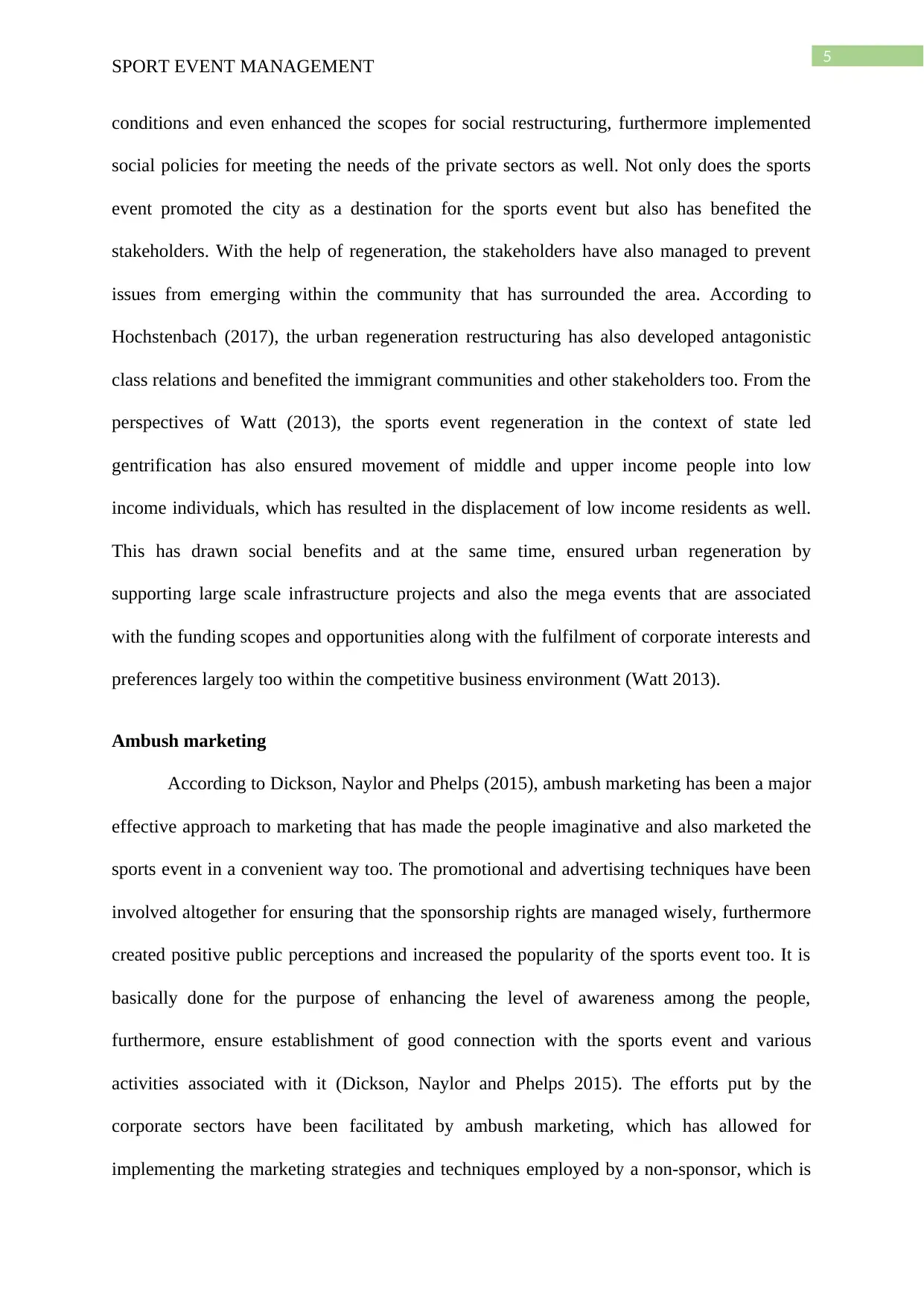
5
SPORT EVENT MANAGEMENT
conditions and even enhanced the scopes for social restructuring, furthermore implemented
social policies for meeting the needs of the private sectors as well. Not only does the sports
event promoted the city as a destination for the sports event but also has benefited the
stakeholders. With the help of regeneration, the stakeholders have also managed to prevent
issues from emerging within the community that has surrounded the area. According to
Hochstenbach (2017), the urban regeneration restructuring has also developed antagonistic
class relations and benefited the immigrant communities and other stakeholders too. From the
perspectives of Watt (2013), the sports event regeneration in the context of state led
gentrification has also ensured movement of middle and upper income people into low
income individuals, which has resulted in the displacement of low income residents as well.
This has drawn social benefits and at the same time, ensured urban regeneration by
supporting large scale infrastructure projects and also the mega events that are associated
with the funding scopes and opportunities along with the fulfilment of corporate interests and
preferences largely too within the competitive business environment (Watt 2013).
Ambush marketing
According to Dickson, Naylor and Phelps (2015), ambush marketing has been a major
effective approach to marketing that has made the people imaginative and also marketed the
sports event in a convenient way too. The promotional and advertising techniques have been
involved altogether for ensuring that the sponsorship rights are managed wisely, furthermore
created positive public perceptions and increased the popularity of the sports event too. It is
basically done for the purpose of enhancing the level of awareness among the people,
furthermore, ensure establishment of good connection with the sports event and various
activities associated with it (Dickson, Naylor and Phelps 2015). The efforts put by the
corporate sectors have been facilitated by ambush marketing, which has allowed for
implementing the marketing strategies and techniques employed by a non-sponsor, which is
SPORT EVENT MANAGEMENT
conditions and even enhanced the scopes for social restructuring, furthermore implemented
social policies for meeting the needs of the private sectors as well. Not only does the sports
event promoted the city as a destination for the sports event but also has benefited the
stakeholders. With the help of regeneration, the stakeholders have also managed to prevent
issues from emerging within the community that has surrounded the area. According to
Hochstenbach (2017), the urban regeneration restructuring has also developed antagonistic
class relations and benefited the immigrant communities and other stakeholders too. From the
perspectives of Watt (2013), the sports event regeneration in the context of state led
gentrification has also ensured movement of middle and upper income people into low
income individuals, which has resulted in the displacement of low income residents as well.
This has drawn social benefits and at the same time, ensured urban regeneration by
supporting large scale infrastructure projects and also the mega events that are associated
with the funding scopes and opportunities along with the fulfilment of corporate interests and
preferences largely too within the competitive business environment (Watt 2013).
Ambush marketing
According to Dickson, Naylor and Phelps (2015), ambush marketing has been a major
effective approach to marketing that has made the people imaginative and also marketed the
sports event in a convenient way too. The promotional and advertising techniques have been
involved altogether for ensuring that the sponsorship rights are managed wisely, furthermore
created positive public perceptions and increased the popularity of the sports event too. It is
basically done for the purpose of enhancing the level of awareness among the people,
furthermore, ensure establishment of good connection with the sports event and various
activities associated with it (Dickson, Naylor and Phelps 2015). The efforts put by the
corporate sectors have been facilitated by ambush marketing, which has allowed for
implementing the marketing strategies and techniques employed by a non-sponsor, which is
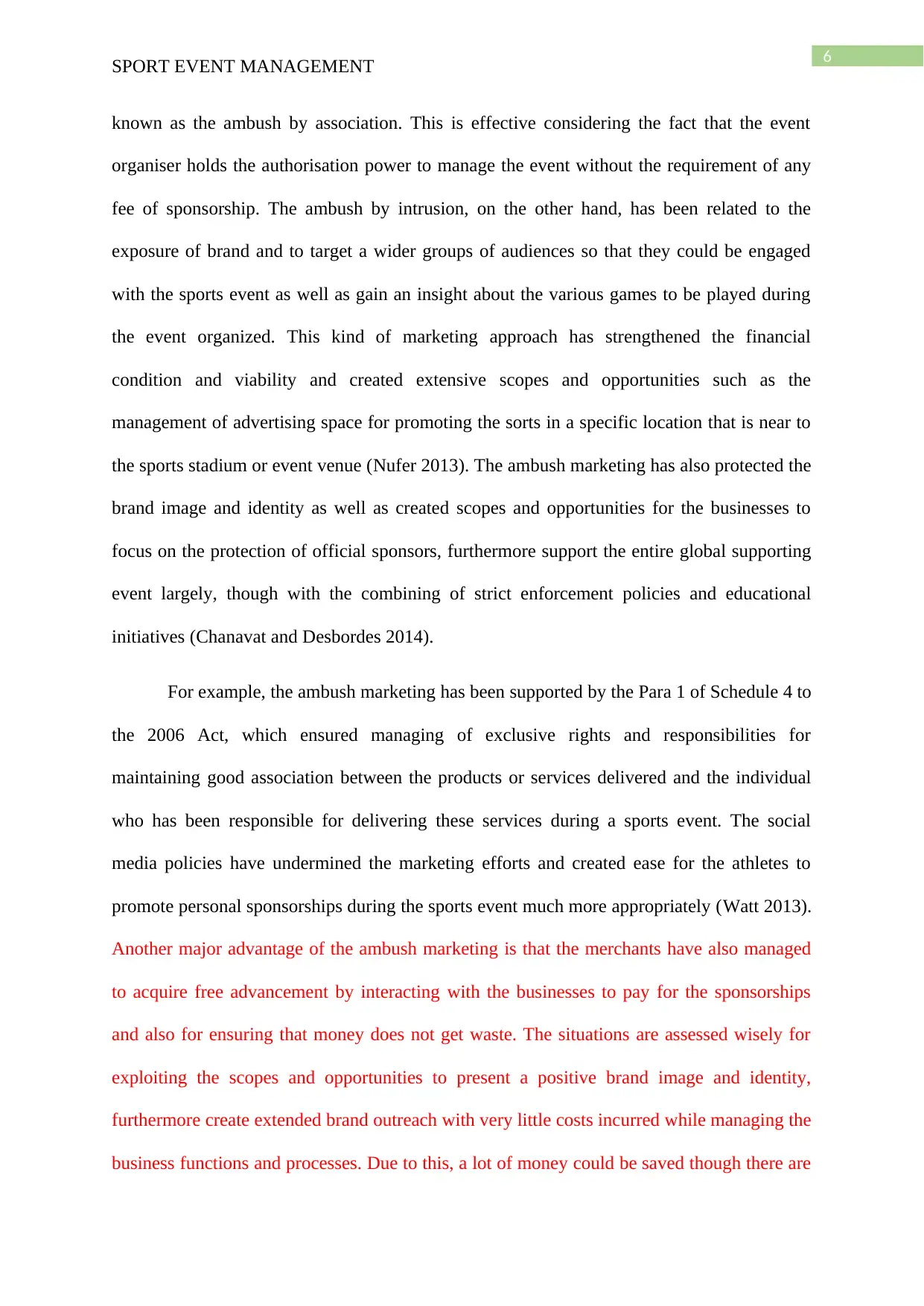
6
SPORT EVENT MANAGEMENT
known as the ambush by association. This is effective considering the fact that the event
organiser holds the authorisation power to manage the event without the requirement of any
fee of sponsorship. The ambush by intrusion, on the other hand, has been related to the
exposure of brand and to target a wider groups of audiences so that they could be engaged
with the sports event as well as gain an insight about the various games to be played during
the event organized. This kind of marketing approach has strengthened the financial
condition and viability and created extensive scopes and opportunities such as the
management of advertising space for promoting the sorts in a specific location that is near to
the sports stadium or event venue (Nufer 2013). The ambush marketing has also protected the
brand image and identity as well as created scopes and opportunities for the businesses to
focus on the protection of official sponsors, furthermore support the entire global supporting
event largely, though with the combining of strict enforcement policies and educational
initiatives (Chanavat and Desbordes 2014).
For example, the ambush marketing has been supported by the Para 1 of Schedule 4 to
the 2006 Act, which ensured managing of exclusive rights and responsibilities for
maintaining good association between the products or services delivered and the individual
who has been responsible for delivering these services during a sports event. The social
media policies have undermined the marketing efforts and created ease for the athletes to
promote personal sponsorships during the sports event much more appropriately (Watt 2013).
Another major advantage of the ambush marketing is that the merchants have also managed
to acquire free advancement by interacting with the businesses to pay for the sponsorships
and also for ensuring that money does not get waste. The situations are assessed wisely for
exploiting the scopes and opportunities to present a positive brand image and identity,
furthermore create extended brand outreach with very little costs incurred while managing the
business functions and processes. Due to this, a lot of money could be saved though there are
SPORT EVENT MANAGEMENT
known as the ambush by association. This is effective considering the fact that the event
organiser holds the authorisation power to manage the event without the requirement of any
fee of sponsorship. The ambush by intrusion, on the other hand, has been related to the
exposure of brand and to target a wider groups of audiences so that they could be engaged
with the sports event as well as gain an insight about the various games to be played during
the event organized. This kind of marketing approach has strengthened the financial
condition and viability and created extensive scopes and opportunities such as the
management of advertising space for promoting the sorts in a specific location that is near to
the sports stadium or event venue (Nufer 2013). The ambush marketing has also protected the
brand image and identity as well as created scopes and opportunities for the businesses to
focus on the protection of official sponsors, furthermore support the entire global supporting
event largely, though with the combining of strict enforcement policies and educational
initiatives (Chanavat and Desbordes 2014).
For example, the ambush marketing has been supported by the Para 1 of Schedule 4 to
the 2006 Act, which ensured managing of exclusive rights and responsibilities for
maintaining good association between the products or services delivered and the individual
who has been responsible for delivering these services during a sports event. The social
media policies have undermined the marketing efforts and created ease for the athletes to
promote personal sponsorships during the sports event much more appropriately (Watt 2013).
Another major advantage of the ambush marketing is that the merchants have also managed
to acquire free advancement by interacting with the businesses to pay for the sponsorships
and also for ensuring that money does not get waste. The situations are assessed wisely for
exploiting the scopes and opportunities to present a positive brand image and identity,
furthermore create extended brand outreach with very little costs incurred while managing the
business functions and processes. Due to this, a lot of money could be saved though there are
Paraphrase This Document
Need a fresh take? Get an instant paraphrase of this document with our AI Paraphraser
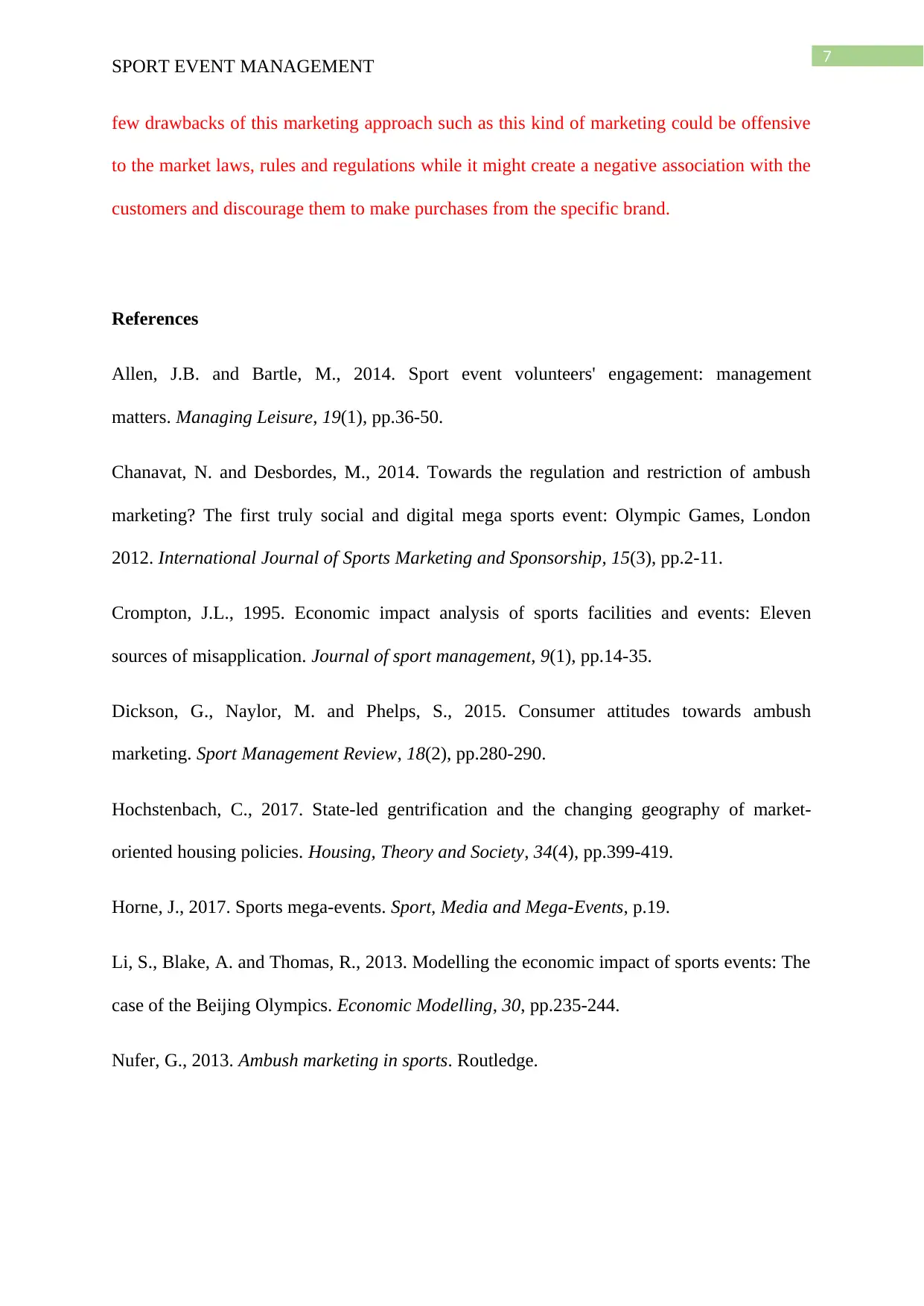
7
SPORT EVENT MANAGEMENT
few drawbacks of this marketing approach such as this kind of marketing could be offensive
to the market laws, rules and regulations while it might create a negative association with the
customers and discourage them to make purchases from the specific brand.
References
Allen, J.B. and Bartle, M., 2014. Sport event volunteers' engagement: management
matters. Managing Leisure, 19(1), pp.36-50.
Chanavat, N. and Desbordes, M., 2014. Towards the regulation and restriction of ambush
marketing? The first truly social and digital mega sports event: Olympic Games, London
2012. International Journal of Sports Marketing and Sponsorship, 15(3), pp.2-11.
Crompton, J.L., 1995. Economic impact analysis of sports facilities and events: Eleven
sources of misapplication. Journal of sport management, 9(1), pp.14-35.
Dickson, G., Naylor, M. and Phelps, S., 2015. Consumer attitudes towards ambush
marketing. Sport Management Review, 18(2), pp.280-290.
Hochstenbach, C., 2017. State-led gentrification and the changing geography of market-
oriented housing policies. Housing, Theory and Society, 34(4), pp.399-419.
Horne, J., 2017. Sports mega-events. Sport, Media and Mega-Events, p.19.
Li, S., Blake, A. and Thomas, R., 2013. Modelling the economic impact of sports events: The
case of the Beijing Olympics. Economic Modelling, 30, pp.235-244.
Nufer, G., 2013. Ambush marketing in sports. Routledge.
SPORT EVENT MANAGEMENT
few drawbacks of this marketing approach such as this kind of marketing could be offensive
to the market laws, rules and regulations while it might create a negative association with the
customers and discourage them to make purchases from the specific brand.
References
Allen, J.B. and Bartle, M., 2014. Sport event volunteers' engagement: management
matters. Managing Leisure, 19(1), pp.36-50.
Chanavat, N. and Desbordes, M., 2014. Towards the regulation and restriction of ambush
marketing? The first truly social and digital mega sports event: Olympic Games, London
2012. International Journal of Sports Marketing and Sponsorship, 15(3), pp.2-11.
Crompton, J.L., 1995. Economic impact analysis of sports facilities and events: Eleven
sources of misapplication. Journal of sport management, 9(1), pp.14-35.
Dickson, G., Naylor, M. and Phelps, S., 2015. Consumer attitudes towards ambush
marketing. Sport Management Review, 18(2), pp.280-290.
Hochstenbach, C., 2017. State-led gentrification and the changing geography of market-
oriented housing policies. Housing, Theory and Society, 34(4), pp.399-419.
Horne, J., 2017. Sports mega-events. Sport, Media and Mega-Events, p.19.
Li, S., Blake, A. and Thomas, R., 2013. Modelling the economic impact of sports events: The
case of the Beijing Olympics. Economic Modelling, 30, pp.235-244.
Nufer, G., 2013. Ambush marketing in sports. Routledge.
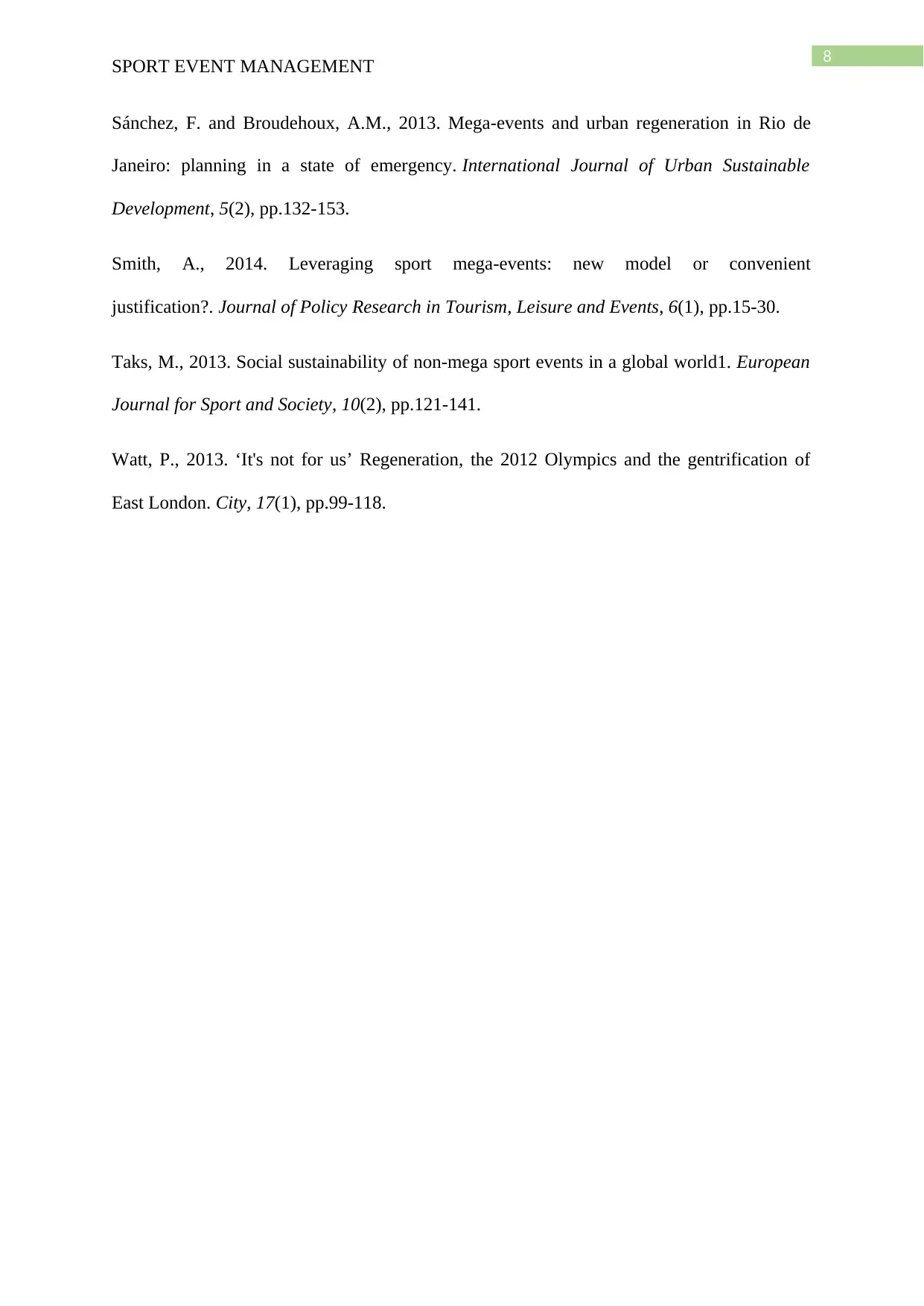
8
SPORT EVENT MANAGEMENT
Sánchez, F. and Broudehoux, A.M., 2013. Mega-events and urban regeneration in Rio de
Janeiro: planning in a state of emergency. International Journal of Urban Sustainable
Development, 5(2), pp.132-153.
Smith, A., 2014. Leveraging sport mega-events: new model or convenient
justification?. Journal of Policy Research in Tourism, Leisure and Events, 6(1), pp.15-30.
Taks, M., 2013. Social sustainability of non-mega sport events in a global world1. European
Journal for Sport and Society, 10(2), pp.121-141.
Watt, P., 2013. ‘It's not for us’ Regeneration, the 2012 Olympics and the gentrification of
East London. City, 17(1), pp.99-118.
SPORT EVENT MANAGEMENT
Sánchez, F. and Broudehoux, A.M., 2013. Mega-events and urban regeneration in Rio de
Janeiro: planning in a state of emergency. International Journal of Urban Sustainable
Development, 5(2), pp.132-153.
Smith, A., 2014. Leveraging sport mega-events: new model or convenient
justification?. Journal of Policy Research in Tourism, Leisure and Events, 6(1), pp.15-30.
Taks, M., 2013. Social sustainability of non-mega sport events in a global world1. European
Journal for Sport and Society, 10(2), pp.121-141.
Watt, P., 2013. ‘It's not for us’ Regeneration, the 2012 Olympics and the gentrification of
East London. City, 17(1), pp.99-118.

9
SPORT EVENT MANAGEMENT
SPORT EVENT MANAGEMENT
Secure Best Marks with AI Grader
Need help grading? Try our AI Grader for instant feedback on your assignments.

10
SPORT EVENT MANAGEMENT
SPORT EVENT MANAGEMENT
1 out of 11
Your All-in-One AI-Powered Toolkit for Academic Success.
+13062052269
info@desklib.com
Available 24*7 on WhatsApp / Email
![[object Object]](/_next/static/media/star-bottom.7253800d.svg)
Unlock your academic potential
© 2024 | Zucol Services PVT LTD | All rights reserved.